On this page:
Principles for parks, street spaces, plazas and communal open spaces
Public spaces are generally located on publicly held land, are accessible to everyone and are managed and maintained by councils or other public agencies. Some privately held land provides for controlled public access and use as a public space, such as a building forecourt, a walk-through, a shopping mall or a communal open space. Public spaces are created as part of a land subdivision or by reallocation of land uses in existing urban areas.
Public spaces accommodate a diversity of activities and provide interest and amenity for people. Critical factors for successful public spaces are:
- location
- size
- dimensions
- interfaces with adjacent properties
- paths
- arrangement of activities within the space.
The area surrounding public spaces also influences how they are used and perceived. A functional system of public spaces offers direct connections to the surrounding pedestrian network and includes through-paths.
Why is it important?
Public spaces are essential for the wellbeing of everyone in a community. They provide opportunity for relaxation, recreation and socialising, and contribute to a neighbourhood's local character and sense of place.
Active, safe and enjoyable public spaces draw people to them.
More than a third of the urban land area is public space, mostly streets.
Green spaces such as parks make up the second largest component of public space. Street spaces, plazas, forecourts and squares provide for regular and chance social encounters. Parks and green spaces provide opportunities to relax, participate in active recreation and experience nature.
Semi–public and communal open spaces, such as courtyards in apartment buildings, hospitals and education facilities, provide for casual interaction and recreation.
3.1.1: ensure all users have convenient and safe access to and through public spaces
- Connect the public space to the surrounding pedestrian network.
- Locate entry paths with clear views to other exits from the public space.
- Continue pedestrian paths through the public space with direct, logical routes.
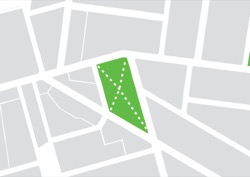
Tip: pedestrians feel safer when a public space has an obvious through–path, with frequent escape routes linking to surrounding streets.
3.1.2: achieve attractive and vibrant public spaces
- Include a diversity of activities in public spaces that extend the hours of use.
Tip: aim for a public space to be attractive to a diversity of users and at different times of the day. A café, play facilities or community uses can assist in activating public spaces.
- Locate features towards the centre of the public space to draw people into and through the space.
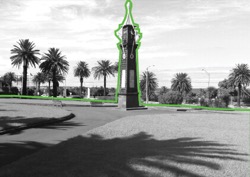
Tip: features could be a large shade tree, fountain or water feature, sculpture, play or performance space. They provide a focus that invites people into the space. - Locate spaces for vendor stalls beside the main pedestrian through–paths.
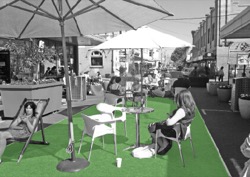
3.1.3: establish and support activity at the edges of public spaces
Edges are often the most populated parts of public spaces. People tend to gravitate to, and occupy, the edges of places because they provide good vantage points to view activities within the space as well as to the surrounding area.
- Arrange doors and windows of buildings to overlook adjacent public spaces.

Tip: public spaces feel safer and are used more when there are opportunities for informal surveillance of the space. - Arrange the public space to allow direct, clear sightlines from surrounding areas into and through public spaces.
Tip: an area’s topography will affect the sightlines and ease of movement to and through a public space.
- Use the edge of a public space for informal seating.
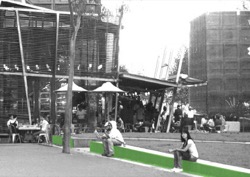
Tip: low walls help define a space and provide informal seating to activate the edge. - Define the boundary or transition between public space and private space without the need for high fences or barriers.
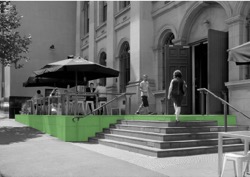
Tip: a slight change in ground level can provide a boundary definition between public and private space.
3.1.4: ensure safety and amenity in public spaces
- Locate public toilets, play and recreation facilities in accessible and active areas.
Tip: facilities that are located in secluded out-of-the-way places feel unsafe and users will avoid them. Refer to 6 Objects in the public realm.
- Install low transparent fencing around children’s play areas near busy streets or bicycle paths.
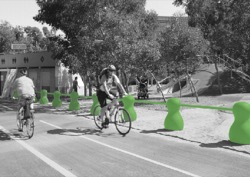
Tip: a low fence between bicycle paths and children’s play areas protects children who may wander on to a street or bicycle path while maintaining its visibility from the street and surrounding areas. - Locate lighting to indicate paths and areas for night-time use.
- Locate utilities infrastructure in a designated zone away from the main pedestrian through-paths and recreation areas.
Tip: poorly located infrastructure such as service control boxes and telecommunications poles can block views, reduce the usable area and pose a hazard to pedestrians and cyclists.
3.1.5: ensure comfortable and enjoyable public spaces
- Arrange paths, seating and main areas to catch the sun during winter and be shaded during summer.
Tip: position trees to provide summer shade and shelter.
- Protect public spaces from the strong winds.
Tip: when planting windbreaks or shade trees, avoid creating concealment opportunities.
- Locate seating to provide users with an interesting outlook and views of the space and opportunity to watch passers–by.
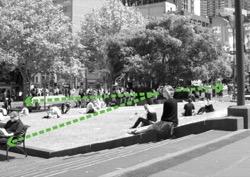
Tip: increase the number of seats in areas that are popular with people. Popular areas are often those with good sightlines of the whole space and its entry points. - In larger public spaces, install signs with maps to show connections and destinations, location of public facilities, and estimated walking times and distances.
3.1.6: support a strong sense of place and local character
- Select planting and landscape elements that support the existing character or preferred future character of the area.
- Select planting and landscape elements that engage the senses.
- Integrate locally relevant urban art.
Tip: urban art that people can interact with is popular and can draw people to a space.
3.1.7: ensure public spaces are well used and maintained
A number of agencies are responsible for managing public spaces. Any one public space may have multiple agencies and organisations with different responsibilities, leading to complexity in coordination of development and management.
- In large, complex public spaces, establish a committee of management with responsibility to coordinate all aspects of the public space management.
- Establish a program of ongoing events and activities for a wide range of users.
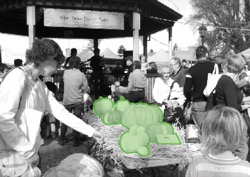
Tip: events and activities can include markets, performances, displays or community services. - Establish a maintenance program for public spaces prioritising prompt identification, removal and repair of any signs of damage and misuse.
- Provide permeable ground surfaces, where possible, for absorption of rainwater and reduction of stormwater run–off.
Page last updated: 09/06/23